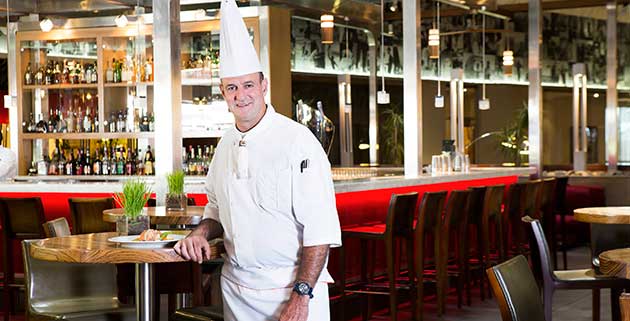Floral Cuisine: Using Flowers in Cooking
Floral Cuisine has become a popular and visible food trend in recent times, so in this article, I share some insights, tips and tricks that I’ve learned about using edible flowers in cooking over a career spanning 16 years. By Chef Alida Giliomee.
The practice of using edible flowers is as old as mankind itself. Ancient gatherers used roots, fragrant scrubs and leaves (herbs), bark and seed (spices) as well as flowers (known for their pleasant pungent aroma) to draw and infuse in potions. Some were used in ancient rituals and some just for the sheer enjoyment of it, but flowers (just as herbs and spices) have always held some mystical power of adornment.
Normally people aren’t sure if the flowers are there for decoration or to be eaten – so, as with any food item, herb or spice, make sure you know if it is to be used for medicinal or consumption purposes. If you are going to eat a flower in its raw form, gently nib off the calyx and stamens which are unpleasant and bitter to the taste. Then start experimenting with different flavour combinations by testing a few varieties. It’s like finding a good bottle of wine: the fun is in the tasting.
Use fresh in salads, dressings, creams and coolers. Use dried and draw as an infusion for your favourite ice tea or stir into sauces, jellies and risotto just before servicing for an Avant Garde approach to dining.
I’m often asked why I use flowers in cooking – is it for presentation or taste? I suppose you can ask the same about any other food item for that matter. The question is not what or why, but why not? Our global palate has been subjected to deeper, lingering aromas and flavours. So yes, there is a consideration and misconception with diners that Floral cuisine might not stand its own ground. However, a better understanding of how to use this delicate ingredient will prove that the pretty flower can sing her own aria on the plate (and not just look the part!).
My favourite edible flowers for use in dishes – both main meals and desserts, are the pungent Lavender, Rose, Chamomile and Jasmine petals and stems. I use them for sweet and savoury. They pair beautifully with beef, lamb, chicken and even pork. Shellfish stand up well to these pungent petals and pairs well with chilli or a splash of white /rose wine.
Gentle infusions come from the Viola, Snapdragon, Sweet William as well as Wisteria (to name but a few). These petals work well with lemon and can be used for sweet and savoury as well (as in the case of the Pungent flowers).
When it comes to my favourite dishes using edible flowers, one of my favourites is a dish I prepared as Plat du Jour at Die Ou Pastorie, in Somerset West years ago. It was a Tulip stuffed with White Choc Mousse, with mock Baklava sheets and a Vanilla-Jasmine infused Honey drizzle. Another favourite would be a classic Lavender Bavarois with Raspberry-rose Coulis and Pistachio Melba.
As with most chefs, the fascination of cooking with these kinds of flowers began with a simple recipe for Rose Petal jam from a Margaret Roberts book I read to within an inch of its life in the CJ Langenhoven Library in Oudtshoorn while still in high school.
As to whether this kind of cooking/garnishing is season specific, there are certain seasonal limitations. However, farmers/urban growers have identified a gap in the market and with greenhouses, humidity and temperature control, the demand has been met.
Importantly, when it comes to working with plant matter (as with animal matter), try to use virgin plants/blooms – untouched by pesticides and additional hormones. These components inherently cause a resistance barrier with the cells and it affects final flavour extraction during cooking. You can really taste the difference in the leaf structure – it is coarser and has a slightly bitter aftertaste.
To give TourismTattler’s readers a better idea of why I recommend using edible flowers in their dishes, here are some of my flavour favourites:
Tulips: Taste like watermelon & dust combined. Torn leaves go great with watercress and chevin (goats cheese).
Marigold: Slight pepperiness and a gentle hint of dusty honey. The pepperiness pairs well with Malay-style curries and works well with Beef tartar.
Hibiscus: Slight musk & redcurrant flavour. Pairs well when drawn for a tea or made into a tempura.
Lavender: Sweet, lingering earthiness with a great deal of tannin. You need to be careful here (just as with a pungent herb like rosemary), for cream/jelly infusions when you need to heat up the lavender, only use the leaves and young stems. The blooms turn the mixture bitter. One such infusion that requires care is Napoleon’s Aphrodisiac – basically, a deep and dark hot choc drink flavoured with lavender and a few other secret spices.
Rose: Believe it or not, this petal’s sweetness is in the aroma. The fresh petal is actually quite bitter. So, when using the petals fresh in a salad or dessert, remember to nip off the white eye of the petal where it tapers down to the calyx.
Wisteria: Just like plumbago it tastes of sweet nectar with a slight grape flavour. Great with Brie and asparagus Quiche or turn it into a heavenly jam and serve with scones and clotted cream.
Sweet Williams (those mini single layer carnations): Musky pepperiness. Great with Sashimi and ginger. Also refreshing as the heat element in a summer Watermelon & Feta salad.
Nasturtiums: Pungent and slightly numbing on the tongue. Pairs well with white meats, fish and shellfish. My favourite is a Salmon and Nastursium Terrine paired with freshly grated radishes and tender stem asparagus.
Borage: Derived from the Celtic word “courage”, it was traditionally brewed into a tea for the men who went off to war. Now it creates peace on the plate with its deep blue regal petals and gentle cucumber flavour. Too delicate to endure heat-use fresh with Panna Cotta or a Chicken & Duck Terrine.
It’s important to note that the type of flower used (as with herb/spice) will influence the listed measures above. Used correctly though, it can contribute to the final composition holistically and not just as window dressing. For example, lavender (as with saffron or cloves) is used sparingly – incidentally both Saffron and cloves are direct flower components (saffron – the stamens from the crocus flower; cloves – the unopened flower buds of a tropical tree).
When it comes to texture, the leaves are delicate, but as with some, you can turn them into tempura/crystallized petals and it immediately turns the tables 180 degrees.
In terms of prepping edible flowers, I recommend rinsing in a light saline solution (salt water to kill or ward off unwanted insects or bacteria), then very gently rinse and shake off additional moisture droplets and place on paper towel sheets. Before consumption remove the calyx with stamens. Separate from flowers for eating, I also use flowers to decorate.
Separate from flowers for eating, I also use flowers to decorate. Whole small flowers can be frozen into ice rings or cubes for a pretty addition to punches and other beverages, which always impresses.
You can also line terrine or jelly moulds with petals. To crystallize the petals, start by lightly brushing with raw egg white and then dusting with castor sugar, then leave to dry and harden. Dry in the windowsill and place in a salt grinder with some Himalayan salt, Pink Peppercorns and garlic flakes for a delicious savoury grind. Or dip the rose petals in chocolate and use as cake/dessert decoration.
In conclusion, as with all herbs/spices, there are two things you need to consider:
- What is the purpose of the product in the dish, and;
- at what time during the cooking /preparation/service process to add it.
Knowledge and timing are key, but then again, all knowledge is there for the taking if we want to wake up and smell the roses…
About the author: Chef Alicia Giliomee is head of the department for Professional Cookery at Capital Hotel School & Training Academy. For more information visit www.capitalhotelschool.co.za















